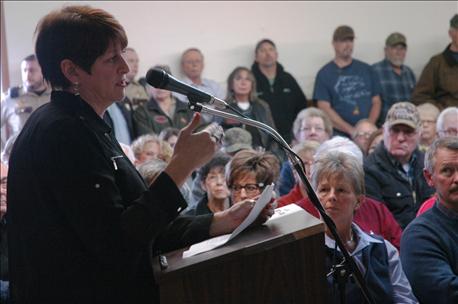March 20, 2016

I’ve been to a few livestock permit hearings in my time at the Dakota Farmer. The one held recently for a proposed 6,432-sow farrowing facility at Buffalo, N.D., was one of the hottest.

Carolyn Dostert testifies against the permit application for a a large hog farm near Buffalo, N.D.
Speaker after speaker from a group called Concerned Citizens of Buffalo testified that they, their child, their parent or a neighbor had severe asthma, chronic obstructive pulmonary disease or heart disease and that fumes the hog farm was going to make their illnesses worse. They citied research studies and surveys from universities, hospitals and activist groups around the country about the health risk posed by large concentration animal feeding operations (CAFOs). Some even read letters from their doctors.
A woman who worked in at a veterinary clinic said that antibiotic resistant bacteria would spread from the hogs to the people in town, creating more asthma and lung disease. I thought she was near tears when she talked about a surgery she had to do a dog because its infection didn’t respond to antibiotics.
One person testified that the hog farm would pose a threat of spreading swine flu, and that Buffalo would be ground zero for an outbreak.
A young father testified that he had moved his family to a rural farmstead for the clean air. He has asthma so bad that living near the sugar beet factories in the Valley had made him ill. His kids were showing signs of asthma, too. They cough every time through drive through West Fargo because of the fumes from the city lagoon.
What’s going to happen to them, he asked, if a hog farm is built a couple miles upwind from their home and hog manure is spread on fields all around them?
Others testified that the hog farm would destroy their dream home, their retirement and their quality of life. They wouldn’t be able to have their windows open, sit on the deck or work in their garden. Their vegetables might not be even safe to eat.
One woman said that she wouldn’t be able to continue running and biking on the country roads near her home because she’d have to go past the hog farm. She breathes deeply when exercising, she said, and how could that be good if you were taking in fumes from the manure pit?
Kathy Tyler, Big Stone City, S.D., testified that she could confirm the fears people had about the odors from swine CAFOs. She lives a large hog farm, Teton Family Farms. You can smell it 2-3 miles away, she said.
Alan Dostert, an architect and president of EAPC Architects Engineers, who lives in the Buffalo area, said he found all kinds of problems with the hog farm’s building design and construction plans. EPAC has offices in North Dakota, South Dakota, Minnesota, Colorado, Vermont and Buenos Aires, Argentina, and offers industrial and commercial architecture and engineering services. Dostert said that due design deficiencies the concrete pit would surely crack and leak, that the barn would sag and deteriorate and that pit gases might build up and explode. In the resulting fire, thousands of animals might perish, and some workers and even a firefighter might die.
Randy Coon, a North Dakota State University economist and Buffalo area farmer, said that manure management plan was flawed, too. More land was needed for manure application or the land would become overloaded with phosphorous. Getting more land close by on which to apply manure was going to difficult because many landowners around in the area had signed pledges not to allow the hog farm’s manure to be spread on their land, or to be pumped across it in hoses to other land. Coon noted that that the he was speaking as a private citizen, not in his capacity as an NDSU employee.
Some opponents prefaced their testimony by saying that they supported agriculture and liked farmers, but not this kind of agriculture and not these farmers. Rolling Green Family Farms and Pipestone Systems, the owner and operator, respectively, are from Pipestone, Minn. They wouldn’t live in Buffalo. They would take all the profits back to Minnesota leaving Buffalo families to bear the burden of ruined roads and polluted water and air.
“Tell them to go back to Minnesota,” said Lee Fischer, of Buffalo, and he didn’t say it nicely.
He and another speaker promised that Concerned Citizens of Buffalo would sue the state if the permit were granted. If the facility were built they would sue the owner and operator for damages to their property values, their health and quality of life.
Proponents points
The North Dakota Farm Bureau, North Dakota Stockmen’s Association and the North Dakota Pork Council testified that their members supported such livestock development in the state. They said that the permit for the hog farm should be granted because the farm clearly met all the state’s environmental, design and zoning regulations.
That should be the only question here, said Scott Ressler, North Dakota Stockman’s Association environmental services director.
Two North Dakota hog farmers testified in support of the farm.
All the bad things you read on the internet about hog farms, “doesn’t come true,” said Craig Jarolimek, a Forest River, N.D., farmer and former president of the National Pork Producers Council. He is a shareholder of Viking Pork and Turtle Mountain Pork, located in northeast North Dakota.
“We are good neighbors,” he said.
Seth Bacon, of Larimore, N.D., a young producer who is president of the North Dakota Pork Council, testified that he loves raising hogs and appreciated the opportunity having hogs in the state gave him to farm.
When Sean Simpson, general counsel for Pipestone Systems, testified, he turned to the side of the community center packed with people who were fighting to stop the project.
“We are not evil,” he said. “We don’t intend to harm you.”
I don’t think any of them believed him.
You May Also Like




